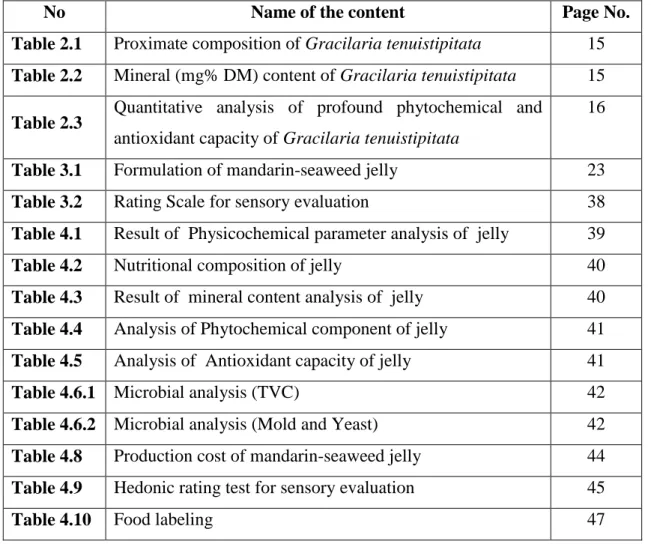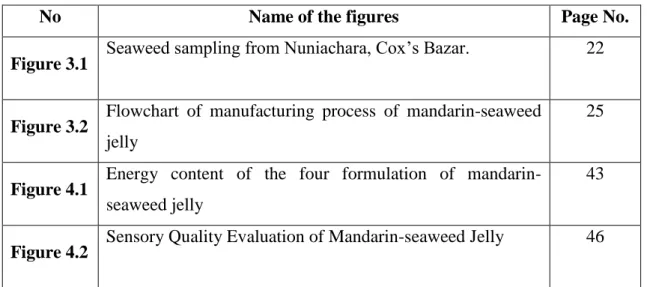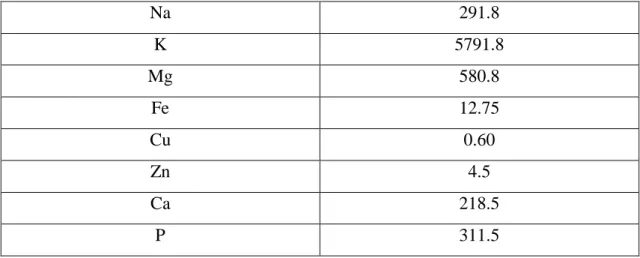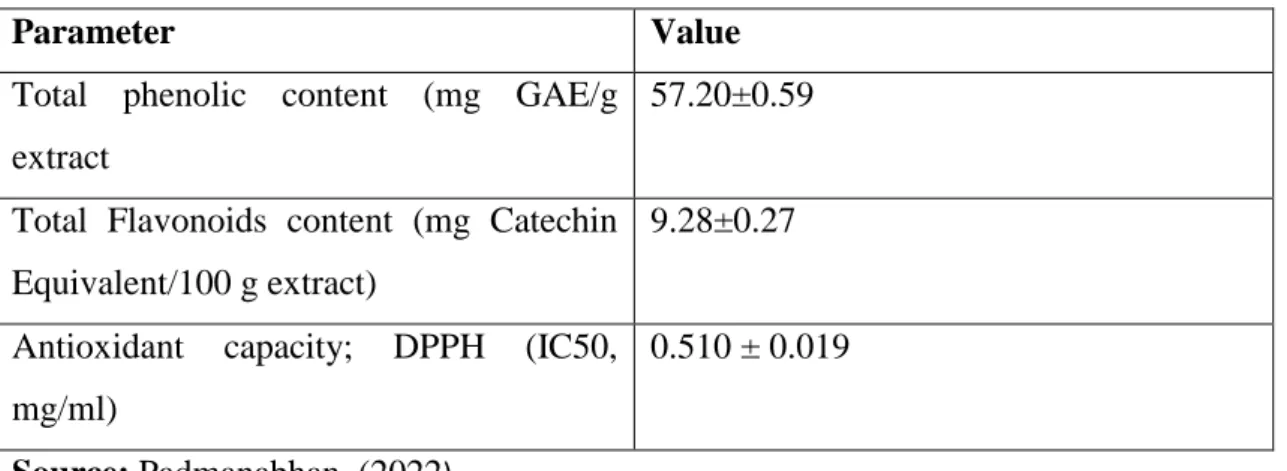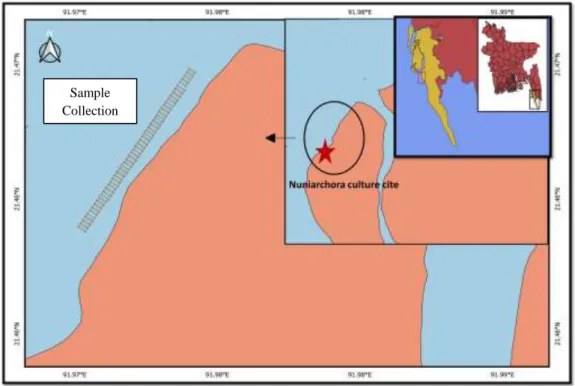The polysaccharides called phytocolloids are a feature of the cell walls of various types of seaweed (Yang et al., 2015). Organic acids, phenols and sugars, among others, are abundant in citrus fruits and contribute to the fruit juice's tasty flavor and aroma (Legua et al., 2014). Citrus juice is one of the most consumed beverages worldwide due to its high nutritional value. value.
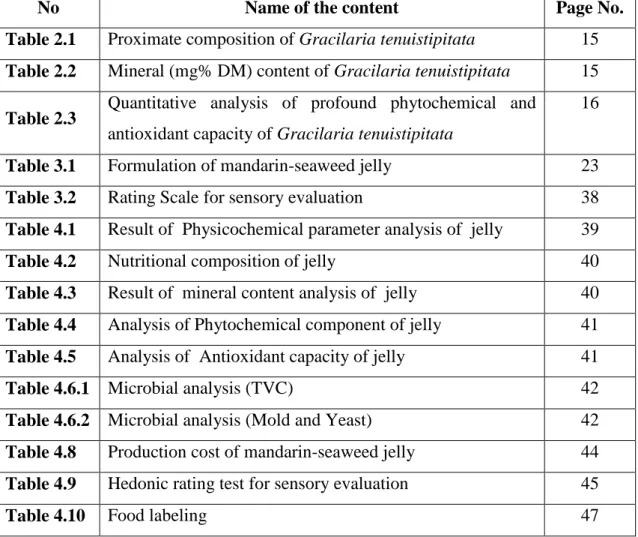
Justification and importance of the study
Aims and Objectives
Review of Literature……………………………………….. 4-21
Potential health benefits from marine algae supplements and
The polyunsaturated fatty acids (PUFAs) and monounsaturated fatty acids (MUFAs) found in marine algae are believed to be good for human health and may even play a role in lowering the risk of cardiovascular disease (Ruxton et al ., 2004). Since ancient times, people in places as diverse as Costa Rica, Japan, China and Egypt have eaten certain types of seaweed (Dillehay et al., 2008).
Overview of Gracilaria tenuistipitata
- General biology of Gracilaria tenuistipitata
- Traditional applications and economic significance
- Potential health effect of Gracilaria tenuistipitata
- Nutritional composition of Gracilaria tenuistipitat
- Phytochemical component
According to Glazer et al., (1983) both agar and phycobiliproteins (PBPs) have been found in Gracilaria tenuistipitata, but PBPs are far less common. The primary PBPs are phycoerythrin (PE,565), allophycocyanin (APC,651) and phycocyanin (PC,621). In addition, it finds application in the cosmetics, food and dyes sectors (Raja et al., 2008).

Overview of Mandarin orange
- Nutritional fact of Mandarin
The concentration of volatile chemicals responsible for the characteristic taste and aroma of tangerines varies according to the level of ripeness, and juice made from unprocessed, unpeeled fruit has been shown to have a higher concentration of these components. Juice is the most studied type of mandarin product, suggesting that it is the most popular value-added product made from mandarins (Barboni et al., 2010). Nam et al. (2019) reported that total soluble solids (TSS), titratable acidity (TA), ripening index, ratio of titratable acidity to total soluble solids, and vitamin C concentration are the most important quality control metrics used in the juice industry for create a high-quality product.
Ye et al., (2011) reported that mandarin oranges have a high concentration of bioactive compounds and even the unripe fruits that are usually discarded due to physiological loss have been recognized as a potential source of nutraceutical compounds that contribute for the improvement of human health, where the free form and the ester form of phenolic acids predominate over the bound phenols. Consumers enjoy tangerines for their delicious taste and high phytochemical content. Mandarins and other citrus fruits and their derivatives are in high demand as more people become health conscious (Putnik et al., 2017).
Therapeutic Uses of mandarin
Pharmacological effects of mandarin
By the way, it contains a lot of vitamin C and flavonoids, which gives it antioxidant properties. Recently, the antioxidant activity of a mandarin juice (MJe) extract rich in flavonoids has been investigated in both cell-free and cell-based experimental paradigms. Ferlazzo et al., 2015) claimed that the human lung epithelium can protect A549 cells from the oxidative stress caused by hydrogen peroxide H2O2 by reducing ROS formation and membrane lipid peroxidation, improving mitochondrial performance and protecting against DNA oxidative damage. Wartenberg and Richter, (2020) said that mandarin oranges are a great source of vitamin A and vitamin C, which help protect the skin from conditions such as acne and pimples.
Rebuilding damaged skin tissue is one of vitamin A's primary actions, making it essential for healing wounds and other skin damage. They also said that vitamin C, which helps boost collagen formation and keep the skin firm and young.
Characterization of mandarin jelly
- Value addition by Seaweed
Compared to other CF juices, mandarin orange juice has been the most researched due to widespread interest in its purported health benefits and widespread consumption around the world. Vitamin A is an excellent nutrient for keeping wrinkles, fine lines and dull skin at bay, thanks to its anti-aging properties. For example, if there is not enough pectin or acid, the jelly will not gel, and if there is not enough sugar, the jelly will be rough.
Seaweed is an excellent source of macro minerals such as nitrogen, oxygen, calcium and selenium and micro minerals such as iron, magnesium and sodium, as well as essential nutrients such as carbohydrates, proteins, lipids and fibre. According to the previous literature review, Mandarin jelly, also known as orange jelly, was developed with the incorporation of seaweed known as Gracilaria tenuistipitata to add value to the culinary product.
Duration of study
Het hele experiment werd uitgevoerd in het laboratorium van Applied Food Science and Nutrition, Applied Chemistry and Chemical Technology, Food Processing and Engineering, Animal Science and Nutrition, en Poultry Research and Training Centre aan de Chattogram Veterinary and Animal Sciences University (CVASU).
Sample Collection
Methodological framework of study
- Preparation of jelly sample
- Manufacturing process of mandarin-seaweed jelly
Tangerine juice extract was included with seaweed extract in three types of different formulations, with the amount of tangerine juice extract and seaweed extract used reversed in two samples and kept the same in the other sample. The latter formulation was made with pure mandarin extract because consumers are familiar with mandarin jelly, so it will be useful to control consumer acceptance compared to the inclusion of seaweed extract in other mandarin jellies.
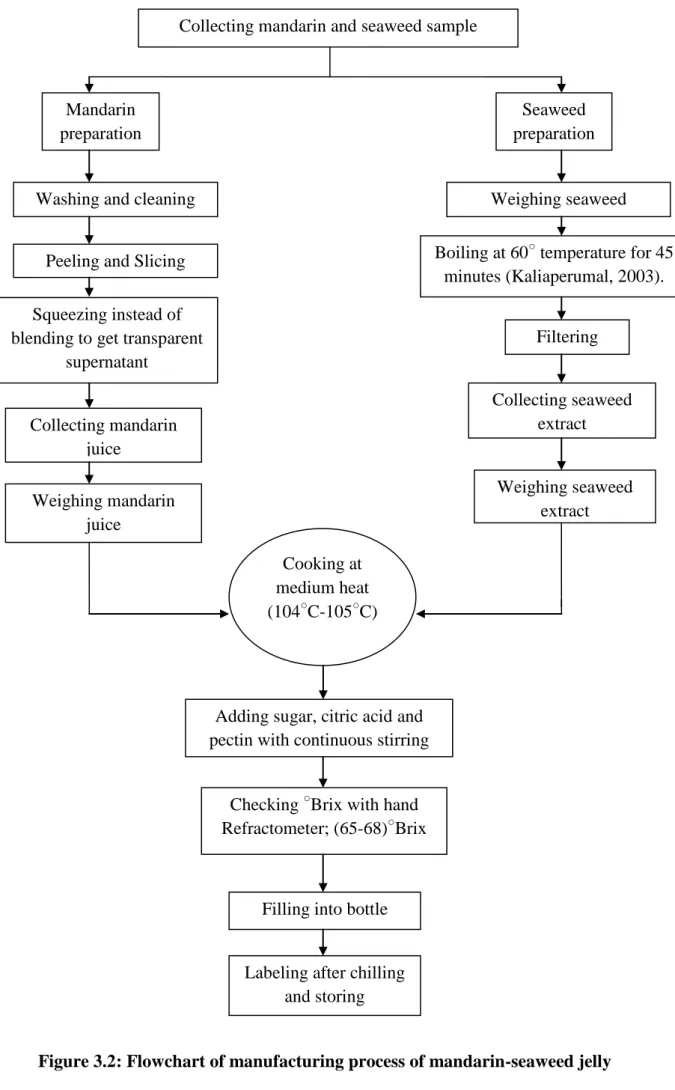
Physicochemical analysis of jelly
- Determination of pH
- Total Soluble Solids
- Titratable acidity
Nutritional composition of jelly
- Moisture content
- Estimation of Ash content
- Estimation of Crude fiber content
- Estimation of fat content
- Estimation of Crude protein content
- Determination of total Carbohydrate
W1 = weight of empty crucible W2 = weight of crucible with ashes W = weight of sample. The crude fat content of the samples was calculated using the AOAC (2016) procedures described for the Soxhlet apparatus. When the volume of ether holding the fat granules of the sample was reduced to an extremely low value, the ether was transferred through the funnel to the beaker.
The Kjeldahl method is used to calculate the amount of nitrogen in both organic and inorganic samples. The Kjeldahl method is also used to determine the amount of nitrogen in wastewater, soil, and several other materials.
Determination of mineral content
- Determination of Sodium (Na)
- Determination of potassium (K)
- Determination of Calcium (Ca)
- Determination of magnesium (Mg)
- Determination of iron (Fe)
The sample solution is prepared by mixing 25 µL of the sample extract with 1 ml of working reagent. To prepare a reagent blank solution, 1 ml of reagent was placed in the cuvette. The information was organized, coded and recorded using MINITAB 19. The results of these experiments were then statistically analysed.
According to Ahmmed et al., (2017), the overall pH range was 2.0 to 5.0 for plain fruit, while the pH for mandarin-seaweed jelly and pure mandarin jelly ranged from 2.91-3.1. The total bacterial counts up to 15 days period were between and it was within the consumption range while comparing with seaweed agar jelly reviewed by Jayasinghe et al., (2016). The total bacterial count fluctuation during storage was noticeably greater.
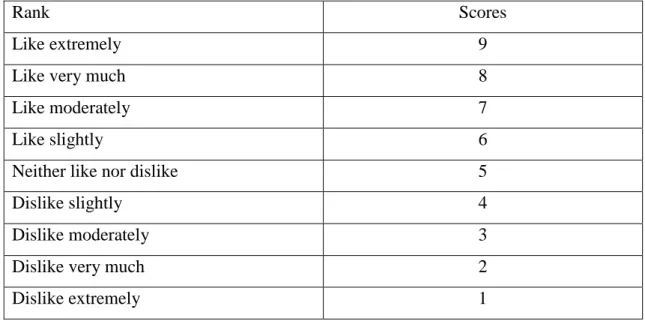
The DPPH radical scavenging assay for antioxidant activity
Determination of Bioactive component
- Total Phenolic content (TPC)
- Total flavonoid content (TFC)
The total phenolic content of the extracts was calculated using a modified version of the Folin-Ciocalteu reagent technique (Al-Owaisi et al., 2014). The total polyphenol content (TPC) of the jelly was calculated using a modified version of the Folin-Ciocalteu method. The total flavonoid content (TFC) in the samples was calculated using the aluminum chloride colorimetric method described by Chang et al.
With a UV-visible spectrophotometer (UV2600, Shimadzu Corporation, USA), the absorbance was measured at 415 nm using a blank solution consisting of the same volume of distilled water and 10% aluminum chloride. Total flavonoid content was calculated and shown as milligrams of quercetin equivalents per milligrams of extract (mg QE/g).
Microbiological analysis
- Aerobic plate count (Bacterial plate count)
- Fungal analysis
It is not a measurement of all the bacteria in the population, but rather a general test for organisms that grow aerobically at mesophilic temperatures (25 to 40 degrees Celsius). The accuracy of the analysis and interpretation of the data largely depends on the accuracy with which the sample was taken. After about 100 ml of the buffered saline solution was added to the beaker, it was thoroughly combined with a back-and-forth motion.
Finally, at 45 °C, 1 ml of the diluted sample was pipetted into each of the empty, sterile Petri dishes containing nutrient agar medium (Plate count agar). On a flat surface, the plates were stirred to combine the contents. After sufficient incubation and confluent development in the areas of strong injection, solitary colonies should be present in the streaked areas of the plate.
Cost analysis
It was then heated while stirring frequently and boiled for one minute to completely dissolve the medium. To process the sample, isolated colonies were obtained by plating the sample on medium using a sterile inoculation loop.
Sensory evaluation
Sensory evaluation of qualitative parameters (taste, appearance, smell, thickness, sweetness and overall acceptance) of the four samples was performed using nine-point Hedonic scales (Larmond, 1977).
Statistical analysis
Result………………………………………………………….. 39-47
- Nutritional Composition of mandarin-seaweed jelly
- Mineral Content of mandarin-seaweed jelly
- Phytochemical composition of mandarin-seaweed jelly
- Antioxidant capacity of mandarin-seaweed jelly
- Microbial analysis
- Energy content of mandarin-seaweed jelly
- Cost analysis
- Sensory evaluation
- Food labeling
Total viable count and fungal count are shown in Table 4.6.1 and 4.6.2, and they were evaluated from 15 days to 3 months after the production of the jelly. Sample C containing 75% seaweed extract and 25% mandarin juice was significantly cheaper than pure mandarin jelly at a price of 330.275 tk for 1/2 kg. According to the results of this research, jelly containing a higher concentration of seaweed extract had greater positive health effects than processed mandarin jelly at a lower price.
Sample C differed significantly from the others in terms of taste, sweetness and thickness, as shown in Table 4.7. Sample-A: 75% mandarin juice with 25% seaweed extract Sample-B: 50% mandarin juice with 50% seaweed extract Sample-C: 25% mandarin juice with 75% seaweed extract Sample-D: 100% mandarin juice with 0% seaweed extract.
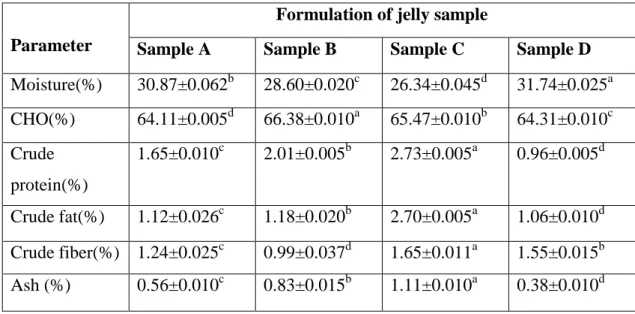
Discussion……………………………………………………. 48-56
- Nutritional composition of mandarin-seaweed jelly
- Proximate analysis
- Mineral Content of mandarin-seaweed jelly
- Bioactive component
- Antioxidant capacity
- Microbial analysis
- Sensory evaluation
In the present study the maximum value was obtained in sample D which is pure mandarin jelly and the least value was found in sample C which has the highest concentration of seaweed and the lowest concentration of mandarin. Jayasinghe et al., (2019) found 1.045% acidity for seaweed jam and the results of the present study found less than their results. The findings in the present study are higher than orange pulp bocaiuva jelly (0.66%) and yellow pulp bocaiuva jelly (0.46%), reported by Silva et al., (2018).
The maximum value was found in sample C which had the highest seaweed extract and the lowest tangerine juice extract and the lowest value was found in sample D which was made with pure tangerine juice extract. The minimum value was found in sample A where the concentration of seaweed extract was the lowest.
Conclusion
Recommendations and Future Perspectives
Total phenolic content and primary antioxidant activity of methanolic and ethanolic extracts of aromatic plant leaves. Chemical composition and biological activity of essential oils of Cleopatra mandarin (Citrus reshni) cultivated in Egypt Journal of Pharmacognosy and Phytotherapy. Total phenolics, organic acids, sugars and antioxidant activity of mandarin (Citrus clementina Hort. ex Tan.): Variation by rootstock.
Evaluation of in vitro antimicrobial and antioxidant activity of peels and pulp of some citrus species. Effect of cultivar and ripening on the phenolic composition and antioxidant activity of mandarin (Citrus reticulate Blanco) and bitter orange (Citrus aurantium L.) seed extracts. Effects of electron beam irradiation on quality attributes of mandarins (Citrus unshiu (Swingle) Marcov) during storage.
Evaluation of Free Radical Scavenging Activity of Various Leaf Extracts of Kedrostis Foetidissima (Jacq.) Cogn.
